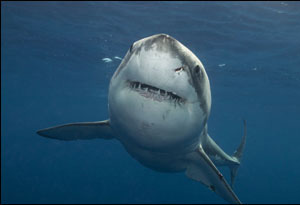
|
 |
 |
 Editorials | Environmental | April 2008 Editorials | Environmental | April 2008  
On the Trail of a Great White
 Jennifer Viegas - Discovery News Jennifer Viegas - Discovery News
go to original


| | As of this writing, the shark is headed toward waters off the Mexican mainland and is now just north of Mazatlan. | | |
Researchers, and anyone else with Internet access, may now track near real-time movements of a juvenile great white shark that was released into the wild by the Monterey Bay Aquarium, which featured the toothsome predator in an exhibit that lasted 5 1/2 months.

As of this writing, the shark is headed toward waters off the Mexican mainland and is now just north of Mazatlan.

"We're confident the shark is doing well, but the big question is whether or not it will fall victim to fishing pressures in Mexico," Monterey Bay Aquarium spokesman Ken Peterson told Discovery News.

"Sharks often wind up as bycatch in fishing operations, so we hope he'll be able to avoid all of the gear," Peterson added.

The shark thus far has evaded other popular fishing grounds. Since it was released six weeks ago, the great white has swum southward, hugging the California coastline and traveling past the southern tip of Baja California.

Where it's ultimately headed is anyone's guess.

"The lives of juvenile white sharks are almost a complete mystery to us," Peterson said. "The released shark is now in relatively warm waters about 656 feet deep, but we don't know if it will travel into the Sea of Cortez, where juvenile great whites have been spotted, or if it will travel more southward, where we have less evidence for shark presence."

He explained that younger great white sharks tend to stay in warm water where they consume fish. As they get older, they often switch to colder water and to hunting and eating mammals, which provide more nutrition and calories.

While the Monterey Bay Aquarium has successfully released all three of the great whites it has had on exhibit since 2004, this latest shark is the first to carry two different tracking tags.

The tag that allows for the day-to-day monitoring is called a Smart Position-Only Tag, or SPOT. It transmits the shark's location via satellite whenever the shark's dorsal fin breaks the surface of the water and the tag makes contact with the satellite. So far, data has been coming in about every two days.

The second tag logs where the shark travels, including water temperature and depth. It is programmed to pop free July 2, when it will transmit its stored data via satellite to researchers at the aquarium and at Stanford University's Hopkins Marine Station in Pacific Grove, Calif.

The information has provided new insights into the far-ranging travels of white sharks in the eastern Pacific, according to Barbara Block, a marine biologist at the station and a principal investigator at TOPP (Tagging of Pacific Pelagics).

She and her colleagues have already identified a great white hotspot they call "The Great White Shark Café." This is a location between Baja and Hawaii that appears to attract multiple adult great whites and some juveniles during the winter and spring. While there, the sharks periodically dive 1,000 feet once every 10 minutes. It's unclear if the sharks dive there to feed, to mate or for some other purpose.

The battery on the recently released great white SPOT tag runs out after eight months, so it's possible that its data might help to resolve the Shark Café puzzle if, that is, the shark survives.

"We're keeping our fingers crossed that he'll make it past fishing nets and hooks to survive to adulthood, when he'll be more than three times longer than he is now," commented Jane Ellen Stevens, a principal investigator and editorial director at TOPP.

She added that, instead of heading to Mexico or Hawaii, "he might even decide to make his fall and spring home territory around the Farallon Islands (off the coast of San Francisco). These rocky isles have enough seals to sustain large white sharks who live in the cold waters of the North Pacific Ocean."

In May, the aquarium will begin its seventh white shark field season.

Peterson said, "We hope to bring in another great white (for exhibit) during the summer or early fall." | 
 | |
 |



